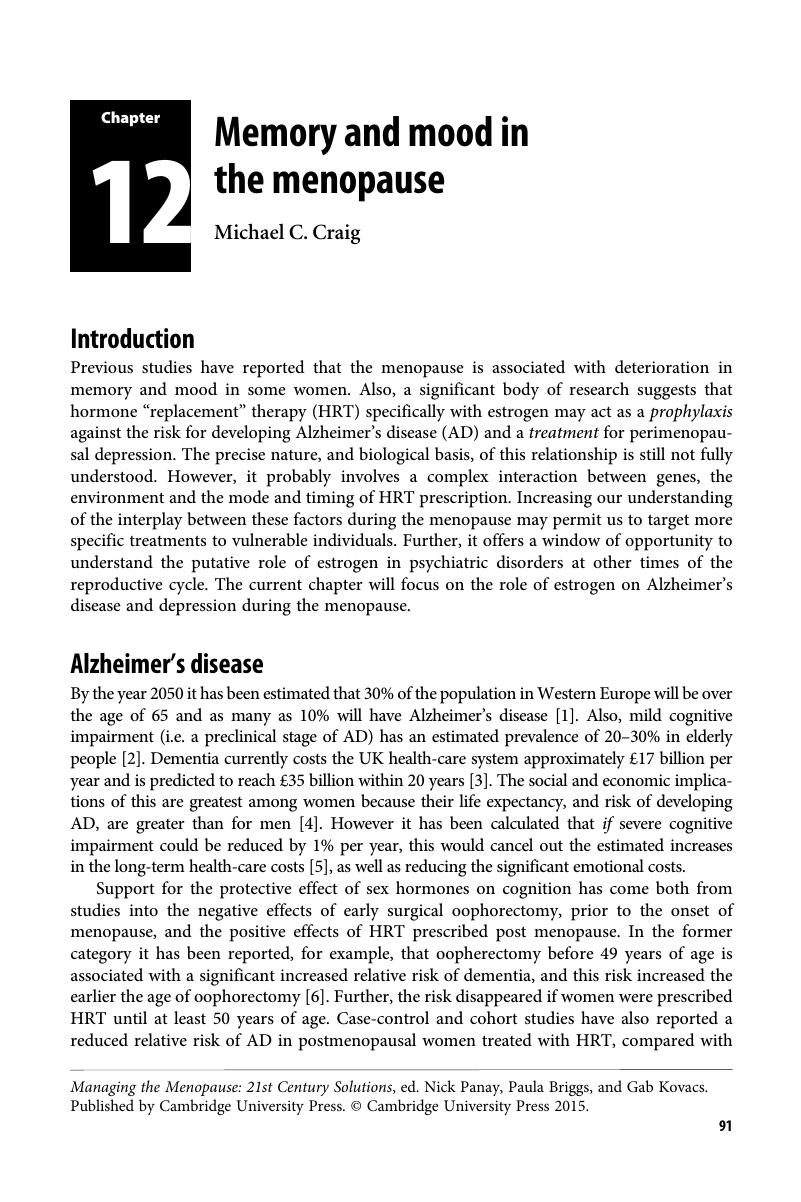Book contents
- Managing the Menopause21st Century Solutions
- Managing the Menopause
- Copyright page
- Contents
- Contributors
- Foreword
- Preface
- Chapter 1 Physiology of the menstrual cycle and changes in the perimenopause
- Chapter 2 The ovarian reserve: predicting the menopause
- Chapter 3 The history and politics of menopause
- Chapter 4 Clinical features of the menopause transition
- Chapter 5 Hormone replacement therapy and cardiovascular disease
- Chapter 6 Pelvic organ prolapse and incontinence in association with the menopause
- Chapter 7 Vulvo-vaginal atrophy
- Chapter 8 Musculoskeletal system and the menopause
- Chapter 9 Osteoporosis recognition and assessment
- Chapter 10 Hormonal management of osteoporosis during the menopause
- Chapter 11 Psychological aspects of the menopause
- Chapter 12 Memory and mood in the menopause
- Chapter 13 Libido and sexual function in the menopause
- Chapter 14 Gynecological pathology in the menopause (excluding cancers)
- Chapter 15 Estrogens used in current menopausal therapies
- Chapter 16 Progestogens used in hormone replacement therapy
- Chapter 17 Androgen therapy for postmenopausal women
- Chapter 18 Selective estrogen receptor modulators used for postmenopausal women
- Chapter 19 Non-hormonal treatments for menopausal symptoms
- Chapter 20 Alternative therapies for the management of menopausal symptoms
- Chapter 21 Contraception for the perimenopausal woman
- Chapter 22 Hormone replacement therapy and cancer
- Chapter 23 Hormone replacement therapy and venous thrombosis
- Chapter 24 Fertility and premature menopause
- Chapter 25 The risk-benefit analysis of hormone replacement therapy in the menopause
- Chapter 26 Premature ovarian insufficiency: hormonal aspects and long-term health
- Chapter 27 Male menopause – similarities and differences with the female menopause
- Index
- References
Chapter 12 - Memory and mood in the menopause
Published online by Cambridge University Press: 05 September 2015
- Managing the Menopause21st Century Solutions
- Managing the Menopause
- Copyright page
- Contents
- Contributors
- Foreword
- Preface
- Chapter 1 Physiology of the menstrual cycle and changes in the perimenopause
- Chapter 2 The ovarian reserve: predicting the menopause
- Chapter 3 The history and politics of menopause
- Chapter 4 Clinical features of the menopause transition
- Chapter 5 Hormone replacement therapy and cardiovascular disease
- Chapter 6 Pelvic organ prolapse and incontinence in association with the menopause
- Chapter 7 Vulvo-vaginal atrophy
- Chapter 8 Musculoskeletal system and the menopause
- Chapter 9 Osteoporosis recognition and assessment
- Chapter 10 Hormonal management of osteoporosis during the menopause
- Chapter 11 Psychological aspects of the menopause
- Chapter 12 Memory and mood in the menopause
- Chapter 13 Libido and sexual function in the menopause
- Chapter 14 Gynecological pathology in the menopause (excluding cancers)
- Chapter 15 Estrogens used in current menopausal therapies
- Chapter 16 Progestogens used in hormone replacement therapy
- Chapter 17 Androgen therapy for postmenopausal women
- Chapter 18 Selective estrogen receptor modulators used for postmenopausal women
- Chapter 19 Non-hormonal treatments for menopausal symptoms
- Chapter 20 Alternative therapies for the management of menopausal symptoms
- Chapter 21 Contraception for the perimenopausal woman
- Chapter 22 Hormone replacement therapy and cancer
- Chapter 23 Hormone replacement therapy and venous thrombosis
- Chapter 24 Fertility and premature menopause
- Chapter 25 The risk-benefit analysis of hormone replacement therapy in the menopause
- Chapter 26 Premature ovarian insufficiency: hormonal aspects and long-term health
- Chapter 27 Male menopause – similarities and differences with the female menopause
- Index
- References
Summary

- Type
- Chapter
- Information
- Managing the Menopause21st Century Solutions, pp. 91 - 101Publisher: Cambridge University PressPrint publication year: 2015

